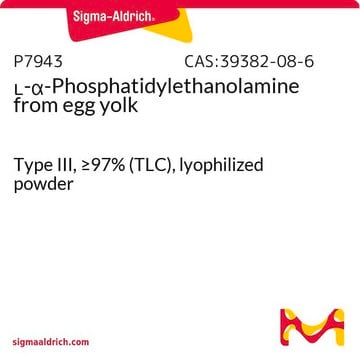L4754
3-sn-Lysophosphatidylethanolamine from egg yolk
Type I, ≥99%
Synonyme(s) :
1-Acyl-sn-glycero-3-phospho(2-aminoethanol), L-α-Lysocephalin, L-α-Lysophosphatidylethanolamine
About This Item
Produits recommandés
Source biologique
egg yolk
Type
Type I
Pureté
≥99%
Forme
powder
Type de lipide
phosphoglycerides
Conditions d'expédition
ambient
Température de stockage
−20°C
Vous recherchez des produits similaires ? Visite Guide de comparaison des produits
Description générale
Application
- to prepare liposomes for liposome binding and vesiculation assay
- as a phospholipid standard in high-performance thin layer chromatography (HPTLC) to detect the phospholipid composition of platelet-derived microparticles
- as a phospholipid standard in thin layer chromatography (TLC) to identify phospholipid in parasitophorous vacuoles (PV) containing Leishmania amazonensis
Actions biochimiques/physiologiques
Qualité
Code de la classe de stockage
11 - Combustible Solids
Classe de danger pour l'eau (WGK)
WGK 3
Point d'éclair (°F)
Not applicable
Point d'éclair (°C)
Not applicable
Équipement de protection individuelle
Eyeshields, Gloves, type N95 (US)
Certificats d'analyse (COA)
Recherchez un Certificats d'analyse (COA) en saisissant le numéro de lot du produit. Les numéros de lot figurent sur l'étiquette du produit après les mots "Lot" ou "Batch".
Déjà en possession de ce produit ?
Retrouvez la documentation relative aux produits que vous avez récemment achetés dans la Bibliothèque de documents.
Les clients ont également consulté
Notre équipe de scientifiques dispose d'une expérience dans tous les secteurs de la recherche, notamment en sciences de la vie, science des matériaux, synthèse chimique, chromatographie, analyse et dans de nombreux autres domaines..
Contacter notre Service technique











